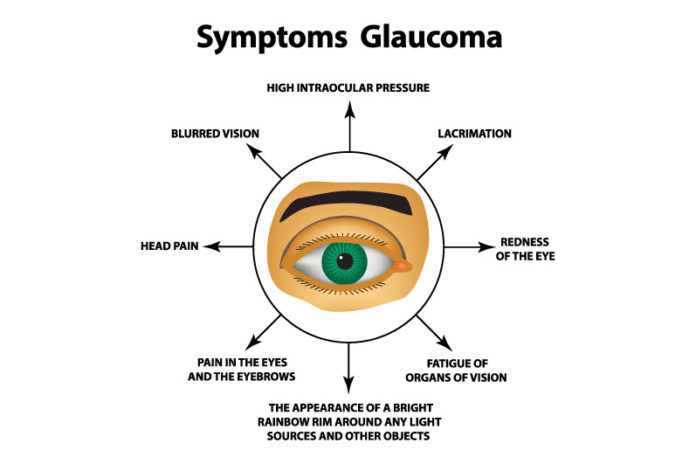Glaucoma is an often painless but serious eye condition that causes damage to your optic nerve.
This nerve connects your eye to your brain, allowing the incoming visual information to be processed by the brain, which then identifies what you’re seeing.
Causes and Risk Factors of Glaucoma
Researchers don't fully understand how glaucoma occurs.
One known cause is the optic nerve becoming compressed because of high pressure within the eye. Another cause can be reduced blood flow within the optic nerve.
Unfortunately, glaucoma has no obvious warning signs and causes no pain. Once damage to your eyesight has occurred, it cannot be reversed.
With an early diagnosis, there are treatments available that can slow the progression of the disease and prevent vision loss.
The top risk factor for glaucoma is having high pressure within your eye.
Other important risk factors include:
- Age; being 40 or older
- African, Hispanic, or Asian heritage
- Thin corneas (the clear layer at the front of the eye)
- Family history of glaucoma
- Farsightedness or nearsightedness
- Previous eye injuries
- Steroid medication use
- Certain conditions, such as diabetes, migraines, hypertension, or poor blood circulation.
What Is Intraocular Pressure?
Within healthy eyes, there's a clear fluid called aqueous humor that circulates to nourish the eye and its various parts. This fluid normally drains out of the eye.
When drainage is slowed, pressure within the eye (called intraocular pressure) can build up and harm the optic nerve by compressing it.
The optic nerve is vital to your ability to see. It carries signals from the retina in the eye to the brain.
Types of Glaucoma
Open-Angle Glaucoma
This is the most common form of glaucoma.
It occurs when the eye's fluid passes too slowly through the open drainage “angle” where the eye's cornea and iris meet.
The first sign of a problem with this type of glaucoma is usually the loss of your peripheral (side) vision.
Low-Tension or Normal-Tension Glaucoma
Angle-Closure Glaucoma
Formerly called narrow-angle glaucoma, this urgent medical emergency occurs when the drainage angle closes because it's blocked by part of the iris.
Eye pressure builds suddenly when fluid can't drain from your eye.
With this type of glaucoma, you'll experience severe pain and nausea. Your eye will redden and your vision will blur.
It's very important to seek emergency treatment immediately at a hospital or clinic. Without treatment, you could lose sight in the affected eye.
Congenital (Childhood) Glaucoma
Babies can be born with a defective angle in the eye that doesn't allow fluid to drain properly.
The symptoms of congenital glaucoma are usually quite noticeable.
Children with the condition may have a cloudy eye, be very sensitive to light, or produce an excess of tears.
Your child's doctor will likely recommend a surgical procedure to correct the problem.
Other types of glaucoma include:
Pigmentary Glaucoma
Traumatic Glaucoma
Injury to the eye that may be caused by blunt trauma to the head or flying debris can lead to glaucoma.
When bleeding in the eye occurs, the eye’s drainage system can become clogged and lead to increased eye pressure.
Irido Corneal Endothelial Syndrome (ICE)
Uveitic Glaucoma
Duration of Glaucoma
Even after glaucoma is treated with medicine or by surgery, the patient will need to be followed for the rest of their lives, says Singh. “That is to make sure they don’t get another form of glaucoma or in case their treatment was not enough, and they now need some additional medical therapy to keep that pressure under control,” she says.
Complications of Glaucoma
Black Americans, Hispanic Americans, and Glaucoma
Black Americans and Glaucoma
Glaucoma occurs about five times more often in Black Americans than in other groups, and blindness from the disease is six times more common. There are many factors that contribute to this disparity, says Singh.
“Genetics appears to have a role as well as things such as access to healthcare or lack of insurance,” she says.
Hispanic Americans and Glaucoma
Resources We Love
American Academy of Ophthalmology
The mission of the American Academy of Ophthalmology is to protect sight and empower lives by advocating for patients, as well as educating the public and eye health professionals.
Glaucoma Research Foundation
This national nonprofit organization is dedicated to finding a cure for glaucoma. It provides information, tips on eye care, and updates on the latest research.
American Glaucoma Society
This professional organization provides clinical and scientific evidence for both patients and healthcare professionals. A patient portal contains resources on finding an eye doctor, education on glaucoma and answers to FAQs.
National Eye Institute
The National Eye Institute was established by congress over 50 years ago to protect and prolong the vision of the American people. This organization provides education and funds research in eye health.
Additional reporting by Becky Upham.
Editorial Sources and Fact-Checking
- Don't Let Glaucoma Steal Your Sight. Centers for Disease Control and Prevention. December 6, 2018.
- Facts About Glaucoma. National Eye Institute. July 28, 2020.
- Glaucoma. MedlinePlus. November 23, 2020.
- Who Is at Risk for Glaucoma? American Academy of Ophthalmology.
- Types of Glaucoma. Glaucoma Research Foundation. June 2, 2020.
- Normal-Tension Glaucoma. Glaucoma Research Foundation. December 10, 2018.
- Angle-Closure Glaucoma. American Academy of Ophthalmology. December 18, 2013.
- Childhood Glaucoma. Glaucoma Research Foundation. October 3, 2019.
- Pigment Dispersion Syndrome and Pigmentary Glaucoma. Glaucoma Research Foundation. October 3, 2019.
- Traumatic Glaucoma. Glaucoma Research Foundation. July 30, 2019.
- What Is Irido Corneal Endothelial Syndrome (ICE)? Glaucoma Research Foundation. August 23, 2012.
- Understanding Uveitic Glaucoma. Glaucoma Research Foundation. October 29, 2017.
- Eye Exam and Vision Testing Basics. American Academy of Ophthalmology. December 17, 2018.
- Glaucoma. Mayo Clinic. October 23, 2020.
- Tonometry. MedlinePlus. November 23, 2020.
- Gonioscopy: What Is It and Why Is It Needed? Glaucoma Research Foundation. June 2, 2020.
- Five Common Glaucoma Tests. Glaucoma Research Foundation. January 9, 2020.
- Glaucoma FAQs. Johns Hopkins Medicine Wilmer Eye Institute.
- Glaucoma: Diagnosis and Treatment. Mayo Clinic. October 23, 2020.
- Hetherington J. Update on Alternative Glaucoma Medications. Glaucoma Research Foundation. September 20, 2018.
- Meier N, et al. Physical Activity, Cardiorespiratory Fitness and Incident Glaucoma. Medicine and Science in Sports and Exercise. November 2018.
- Glaucoma. American Optometric Association.
- Understand Your Glaucoma Diagnosis. Glaucoma Research Foundation. October 29, 2017.
- Ou Y. Glaucoma Surgery Series: The Risks and Benefits of Glaucoma Surgery. BrightFocus Foundation. April 23, 2018.
- Glaucoma Data and Statistics. National Eye Institute. July 17, 2019.
- Elam AR, et al. Large Disparities in Receipt of Glaucoma Care Between Enrollees in Medicaid and Those with Commercial Health Insurance. Ophthalmology. October 2017.
- Berchick ER, et al. Health Insurance Coverage in the United States: 2018. United States Census Bureau. November 2019.
- Varma R, et al. Prevalence of Open-Angle Glaucoma and Ocular Hypertension in Latinos: The Los Angeles Latino Eye Study. Ophthalmology. August 2004.
- Hispanics and Latinos Have Higher Risk for Vision Loss. Centers for Disease Control and Prevention. April 27, 2020.
- Common Eye Disorders. Centers for Disease Control and Prevention. June 3, 2020.
- Dry Eyes and Glaucoma. Double Trouble. Glaucoma Research Foundation. October 1, 2020.













































